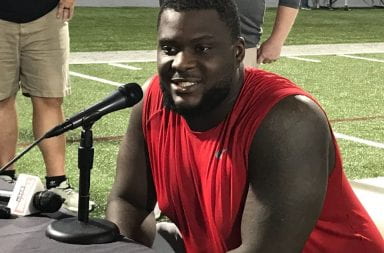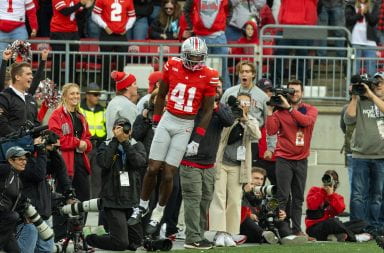
Jake Boswell, associate professor of landscape architecture at Ohio State, teaches Siebert Elementary students about how architects measure space and scaling.
Credit: Michelle O’Sullivan
A collaboration between the Columbus City School District and Ohio State, made possible by the STEAMM Rising program, will bring over 125 elementary school students to Knowlton School of Architecture this week.
The STEAMM Rising program aims to instill passions for science, technology, engineering, art, mathematics and medicine in today’s youth, according to its website. Third, fourth and fifth graders from Siebert Elementary will participate in one of the program’s educational exercises Wednesday, Jake Boswell, associate professor of landscape architecture at Knowlton, said.
Siebert’s students have been tasked with designing a new playground for their school, Boswell said. He said this exercise is rooted in reality, seeing as the school’s current playground could be greatly improved.
“Siebert’s playground has no shade,” Boswell said. “When kids are outside, a lot of them just end up drawing with sidewalk chalk near the edge of the building.”
Michelle O’Sullivan, an art educator at Siebert Elementary, said students have been conceptualizing ideas for the new playground since the beginning of the school year.
“Students created model playgrounds in groups, using only paper and tape to the scale of a LEGO person,” O’Sullivan said. “Then they created a plan view, or an overhead view, of their playground.”
Boswell said the students will present their designs to Knowlton academics, staff and faculty between 10 and 11:30 a.m. Wednesday.
“We want them to discuss what they are thinking because each person has a different understanding while looking at visualizations,” Boswell said. “This also allows for the kids to practice their public speaking skills.”
Boswell said the program’s goal of encouraging children to pursue careers in the design fields is especially important in Siebert’s case, as the school has one of the highest percentages of English as a second language — also known as ESL — in the entire district.
“Traditionally, kids who are ESL are not exposed to design, and that is unfortunate,” Boswell said. “This field gives you a way to directly and physically impact your environment.”
O’Sullivan said this project has allowed her students to acquire valuable learning and life skills.
“This can result in real projects, jobs and careers,” O’Sullivan said. “They’ve been exposed to a real problem and had to use new vocabulary and techniques for designing, drawing and sculpting.”
Though the project may never develop past the planning stage, O’Sullivan said the need to dream remains significant.
“Without a dream, nothing will ever happen,” O’Sullivan said. “We started with the children’s book ‘My Dream Playground,’ and the students really embraced the idea of dreaming big.”
Ultimately, O’Sullivan said teaching students about architecture’s realistic capacities and limitations has been its own reward.
“This project has created an opportunity to demonstrate the larger breadth of my teaching,” O’Sullivan said. “Being able to show my students that large projects take time, many versions and multiple drafts, allows me to teach them how life is.”
Boswell said Knowlton’s studio students view the upcoming visit as an exciting way to consciously engage with Columbus’ wider community.
“The students at Siebert got super excited and were happy to imagine what their playground could be,” Boswell said. “When you have that experience, it makes the work you’re doing feel meaningful in a way that we can’t simulate outside of working with a community in that way.”
More information about Ohio State’s involvement in the STEAMM Rising program can be found on The Lantern or via the program’s website.


